
Recently on Cyclingnews.com |
Tales from the (cobbled) peloton, April 14, 2007 - Page 1 of 2
A breakdown of Hell: The pavé of Paris-Roubaix
This coming Sunday, the roads of northeastern France will once again play host to the biggest one-day bike race in the world, Paris-Roubaix. But these are no ordinary roads, as Cyclingnews' resident pavé basher Ben Atkins finds out.
Unlike Flanders, the secteurs (the French word for sectors) count you down to the finish, which in one way is good as it lets you know where you are in relation to the finish - but it also lets you know exactly how many more times your body is going to have to be put through this torment!

|
Secteur 28 - Troisvilles à Inchy
Length: 2.2 km
Rating: ***
Km from start: 98
Km from finish: 161.5
It begins.
The route turns off the main road out of the picturesque village of Troisville on to a narrow track and first timers get a nice rude awakening as to why this race is so special. Sadly for the many riders here under sufferance, the feed zone is another 47km away - the Euskaltel team springs to mind here, now forced to ride under ProTour regulations, but teams like this have always taken part in order to curry favour with the organisers ASO, so that they could get a Tour de France invitation.
Mercifully, this secteur is one of the more rideable ones, it has a gentle slope in the riders' favour and isn't too badly surfaced. Only when it takes a right angle left hander towards the village of Inchy does it start to rise gradually, but it's soon over and the course rejoins the modern world again.
Secteur 27 - Viesly à Quiévy
Length: 1.8 km
Rating: ***
Km from start: 104.5
Km from finish: 155
A small chapel marks the start to this secteur - which some of the more religious members of the peloton may find useful - it's also very muddy, so if it's a wet day they'll have to be careful. Like the previous secteur, this one slopes gently downwards for almost its entire length, so isn't as tough as it might be.
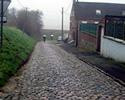
|
Secteur 26 - Quiévy à Saint-Python
Length: 3.7 km
Rating: ****
Km from start: 107
Km from finish: 152.5
A gap between two buildings in the village of Quiévy sees the start of this next secteur. It's generally - relatively - pretty well surfaced and starts off fairly level, but before too long the inevitable patched up tarmac area appears and it becomes much more of a false flat rising up between fields on either side. Suddenly, the "road" takes a sharp right hander and heads directly for the village of Saint-Python - it's relationship to Monty and his Flying Circus is currently unestablished.
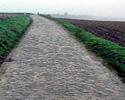
|
Secteur 25 - Saint-Python
Length: 1.5 km
Rating: **
Km from start: 111.5
Km from finish: 148
The peloton has barely recovered from the rattling of the previous secteur, when this one begins. Thankfully though, this is not too bad a one, the surface is relatively benign - the cobblestones are relatively small and tightly packed - and again it slopes gently downwards as it snakes gently across the rural landscape. This is certainly one of the easier secteurs.
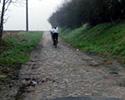
|
Secteur 24 - Vertain à St-Martin-sur-Ecaillon
Length: 1.9 km
Rating: ***
Km from start: 119.5
Km from finish: 140
Running alongside a small wood, this secteur is pretty well surfaced and descends very gradually for its entire length. First used in 2005, its brief history in the race has yet to cause much of a problem to anyone, partly due to its lack of severity, but also due to the fact that there is still so far to go.
Secteur 23 - Capelle-sur-Ecaillon - Le-Buat
Length: 1.7 km
Rating: ***
Km from start: 126.5
Km from finish: 133
This one is a bit nasty. Despite the rating of only three stars - mostly because the surface isn't as bad as it could be - it's quite a difficult secteur. The first few hundred metres descend at a fairly rapid rate (although nothing like the Kemmelberg in Gent-Wevelgem!) and riders will want to build up as much momentum as possible on this part because once it bottoms out it begins to climb at a rate of 7% for several hundred metres. Nothing by Tour of Flanders standards, but nevertheless enough to sap the legs, especially of the inevitable breakaway riders.
Secteur 22 - Verchain-Maugré à Quérénaing
Length: 1.6 km
Rating: ***
Km from start: 138.5
Km from finish: 121
Nothing too bad by way of difficulty here. The cobbles rise gently in a false flat for the first part, and then descend gently the rest of the way. Unlike most other secteurs, this one is an almost dead straight line across the countryside.

|
Secteur 21 - Quérénaing à Maing
Length: 2.5 km
Rating: ***
Km from start: 141.5
Km from finish: 118
This is quite a long secteur, but it's only been given three stars by virtue of the fact that other than a gentle false flat for a few hundred metres in the first half, it's mostly downhill. The last kilometre or so descends quite rapidly and requires a great deal of concentration as this kind of surface can dislodge bottles. It's also very muddy, so it is important to try and ride on the most level part possible. This is usually the crown of the road as the wheeltracks on both sides tend to be either off camber or full of potholes - or sometimes both.
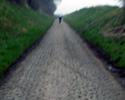
|
Secteur 20 - Maing à Monchaux-sur-Ecaillon
Length: 1.6 km
Rating: ***
Km from start: 144.5
Km from finish: 115
Mercifully, the cobbles on this secteur are pretty good, coming as it does, less than a kilometre after the previous secteur. The cobbles come thick and fast in some parts and their cumulative effect can start to be felt even at this stage, especially by those domestiques assigned early duties, and those who aren't built for this kind of punishment.
This one is not easy though, despite its good surface, as the first two thirds or so take the form of a false flat before it descends gently for the final part.
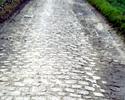
|
Secteur 19 - Haveluy à Wallers
Length: 2.5 km
Rating: ****
Km from start: 156
Km from finish: 103.5
This is the beginning of the softening up process as the race approaches its final hundred kilometres. Riders have been able to have a bit of a break since the last secteur, but this one will make a lot of people hurt! It's relatively flat, with only a slight rise during the first half, but even this can be felt as the uneven surface does its best to check your progress. Throughout its length, the cobbles are in a variety of states ranging from well arranged and smooth to seemingly random which will destroy the rhythm of a lot of riders and allow the strong teams to begin applying the pressure in anticipation of the next, legendary part of the race.
Secteur 18 - Tranchée (ou Trouée) d'Arenberg
Length: 2.4 km
Rating: *****
Km from start: 164
Km from finish: 95.5
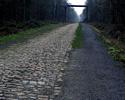
|
What can you say about Arenberg that hasn't been said a million times before. For many people - fans and detractors alike - this is the essence of Paris-Roubaix. Despite the fact that it's still nearly 100 km from the velodrome, there is always incident. This is the point where - because of the extremity of the surface - the favourites start to put the hurt on to the also-rans, and hopefully on to each other. Discovered by former Tour winner - and local boy - Jean Stablinski, and introduced in the 1968 race (the first "modern" edition), it's been a fixture ever since 1983, except for in 2005 when it was decided that it was too dangerous and had to be repaired.
Because of the shelter given by the overhanging trees along its length, and because of the underground aquifer that is reputedly very close to the surface, the ground here never seems to fully dry out. Coupled with the subsidence that hundreds of years of mining can cause to the area, this is one of the most unbelievable roads in the world. In recent years there have been a number of serious incidents here that have put its use in jeopardy, most notably in 1998 when Johann Museeuw fell and smashed his kneecap just a week after his dominant third victory in the Tour of Flanders, causing the organisers to run the course from the opposite end so that they wouldn't hit it so fast.
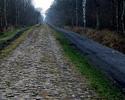
|
Until a few years ago, it was possible to ride along the mud at the sides, amongst and even behind the spectators, but the organisers have now put barriers along the length of the Trouée to prevent this. Now everybody gets to experience the seventh level of Hell!
The race hits this secteur at the end of a long straight road out of the picturesque old mining town of Arenberg so they're generally travelling at speeds of up to 60 km/h. On dry days all they have to cope with is the fact that it seems to be surface with randomly sized stones, arranged in an uneven and seemingly random way. If it's wet then the stones will also be glacially slippery. It slopes gently downwards for the first few hundred metres allowing riders to maintain, or even increase their speed, before levelling off and sloping ever so slightly upwards for the remainder of its length. The unevenness of the surface makes this slight gradient seem a thousand times worse.
There are always crashes here, because everybody wants to be near the front at this point. Mud on the cobbles - churned up by race vehicles, and often deliberately by the thousands of fans who always come here - makes it all the more treacherous.
They don't give this one five stars because of its soft bathrobes!
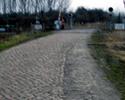
|
Secteur 17 - Wallers à Hélesmes
Length: 1.6 km
Rating: ****
Km from start: 170.5
Km from finish: 89
Another landmark on the course comes in the middle of this secteur; the "Pont Gibus". There are a number of disused and dismantled railways in this area, and one of them used to have a bridge across here. What's left though is effectively a gateway through the old embankment as the whole of the top has long since been removed.
The surface starts benign enough, apart from the mud, and then crosses the new railway (watch out for trains!) before giving way to an almost completely mud covered surface to pass through the old Pont. Once through here the cobbles return from under the boue as it snakes across some fields next to a small stream. As reflected in its four star rating, there are a lot of uneven patches and sunken areas which will fill with water if there's any rain around at all, so it's a really tough secteur, especially, coming as it does, straight after Arenberg.
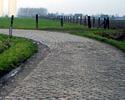
|
Secteur 16 - Hornaing à Wandignies - Hamage
Length: 3.7 km
Rating: ***
Km from start: 177
Km from finish: 82.5
Despite its length, this secteur is not too bad - hence just the three stars - and it has one of the best kept surfaces of any of the secteurs on the course.
Leaving the village of Hornaing it meanders across the fields, past a few houses, and skirts alongside the railway line for a while before turning right and passing beneath the shadow of another of the course's landmarks, the enormous twin water towers that serve the local villages. After passing the towers, there is a short rough asphalt patch, before the cobbles return and it heads straight across to Wandignies - Hamage where it finishes adjacent to a bunch of houses.

|
Secteur 15 - Warlaing à Brillon
Length: 2.4 km
Rating: ***
Km from start: 184.5
Km from finish: 75
Legs are getting tired by now, and along comes another long secteur to punish those who are not on top of their form. The surface is pretty good for the first kilometre and a half or so before deteriorating quite badly for the final part, which features a lot of quite large holes making the ideal line worth fighting for. None of the favourites will be making their move just yet, but there will be a constant trickle of exhausted riders dropping off the back of what will by now be a pretty small front group.
After a right-angled left hander at the beginning, this is an almost dead straight line across the countryside of the Nord, so it's always possible to see the bunch as it disappears into the distance; good if you're a fan, not so good if you're a rider trying to keep up...
Click here for the second page, featuring the final 14 secteurs and a full list of photos.
